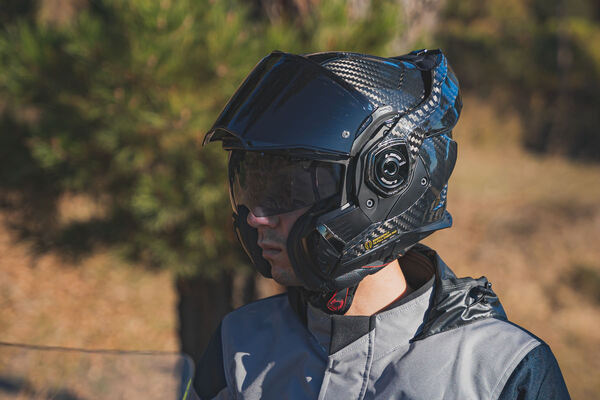For motorcyclists, one of the most important decisions they make when gearing up is selecting the right helmet. While safety is paramount, comfort is equally important, especially for long rides. An uncomfortable helmet can cause neck pain, sweating, irritation, and fatigue—factors that could affect both your ride quality and safety. That’s why choosing a helmet that provides comfort during extended periods on the road is essential.
In this article, we will dive into what makes a helmet truly comfortable for long rides. From the fit and material to the ventilation system and weight distribution, several factors play a key role in ensuring that your helmet is not just protective but also comfortable over long distances.

1. Perfect Fit: The Foundation of Comfort
The most critical factor in achieving comfort for long rides is the fit. A helmet that doesn’t fit correctly can cause discomfort, pain, or even lead to dangerous situations on the road. A properly fitting helmet should be snug but not overly tight, with no pressure points on your forehead, cheeks, or the top of your head. A helmet that’s too loose may move around and not provide optimal protection, while a helmet that’s too tight can lead to headaches and fatigue.
How to Ensure a Proper Fit:
- Head Shape: Helmets come in different shapes to suit various head types (round, oval, long-oval). Ensure you choose a helmet that matches your natural head shape for a secure fit.
- Padding: Most helmets come with adjustable padding, which helps customize the fit. Consider helmets with removable and washable liners, which provide added comfort and hygiene.
- Size: Always measure your head circumference before purchasing a helmet. Don’t rely on your hat size; instead, measure around the widest part of your head (just above the eyebrows) for the most accurate fit.
A comfortable helmet will fit snugly around your head without excessive pressure or gaps, allowing for better comfort and safety during long rides.
2. Weight Distribution: Light Yet Protective
One of the key aspects of comfort in a helmet is its weight. A heavy helmet can put undue stress on your neck and shoulders, especially during long rides, leading to soreness and fatigue. However, the helmet must still meet safety standards, which means balancing weight and protection is crucial.
Materials for Lightweight Helmets:
Modern helmets often use advanced materials to maintain strength while reducing weight. Look for helmets made from:
- Carbon Fiber: Carbon fiber helmets are incredibly strong yet lightweight. They offer the same level of protection as heavier helmets but with much less strain on your neck and shoulders.
- Fiberglass: While slightly heavier than carbon fiber, fiberglass is still a relatively light material for helmets. It provides durability and comfort while remaining strong.
- Polycarbonate: Polycarbonate helmets are often more affordable, and though they may weigh slightly more than carbon fiber, they are still lighter than traditional plastic options and offer sufficient protection.
Choosing a lightweight helmet that uses high-quality materials is essential for preventing neck strain and ensuring comfort on long rides.
3. Ventilation: Stay Cool on the Road
Riding for extended periods can cause you to work up a sweat, especially on hot days. Good ventilation is crucial to maintaining comfort during long rides, as it prevents overheating and reduces the chances of discomfort or even fatigue due to excessive sweating.
How Ventilation Impacts Comfort:
- Airflow Channels: A well-designed ventilation system helps direct cool air through the helmet while pushing out hot air. This airflow can reduce the buildup of sweat, keep your head cooler, and prevent the interior of the helmet from becoming stuffy.
- Adjustable Vents: Some helmets offer adjustable ventilation, allowing you to increase or decrease airflow based on the weather conditions. In colder conditions, you can close the vents for warmth; in hotter weather, you can open them for maximum airflow.
Look for helmets that offer both front and rear vents to maximize cooling. Additionally, ensure that the vents are strategically placed to avoid wind buffeting or excessive noise.
4. Noise Reduction: Protecting Your Ears and Comfort
Noise can be a significant factor when riding long distances, especially at high speeds. Wind noise can lead to ear fatigue, making the ride uncomfortable. A well-designed helmet can help reduce noise levels, ensuring that you remain focused on the road and less distracted by irritating sounds.
Features to Look for:
- Aerodynamic Design: Helmets designed with aerodynamics in mind tend to create less wind resistance, reducing wind noise. The shape of the helmet can help minimize turbulence around the ears and reduce distracting sounds.
- Padding Around the Ears: Extra padding around the ear area can help dampen external noise, making your ride more enjoyable.
- Chin Curtains: Some helmets come with chin curtains or neck rolls that further reduce wind noise and help with the overall comfort by blocking out wind drafts.
By selecting a helmet that incorporates noise-reducing features, you can enjoy a quieter and more comfortable ride, which is essential for long-distance touring.
5. Liner and Padding: Cushioning for Comfort
The padding and liner inside a helmet play a major role in comfort. High-quality foam padding absorbs impact and provides a cushioned feel, which reduces pressure points and enhances comfort. It also contributes to the overall fit of the helmet.
Key Padding Features:
- Removable and Washable Liners: For long rides, it’s important to have a helmet with removable and washable liners. These liners help maintain hygiene and allow you to keep the interior of your helmet clean and fresh, even after long hours of use.
- Moisture-Wicking Fabric: Many modern helmets feature moisture-wicking fabric that helps to draw sweat away from your skin, keeping your head dry and cool. This feature is essential for riders who take long trips in hot weather.
- Customizable Fit Pads: Some helmets come with adjustable or customizable fit pads, which allow riders to fine-tune the internal fit for maximum comfort.
Ensure your helmet has adequate padding around key areas such as the forehead, temples, and chin strap for an optimal fit that won’t create uncomfortable pressure points during long rides.
6. Chin Strap and Buckles: Secure and Comfortable
The chin strap is another critical part of the helmet, and it must be both secure and comfortable. A poorly designed chin strap can cause irritation or discomfort, particularly during long rides when the rider is adjusting the helmet repeatedly.
What to Look for:
- Quick-Release Buckle: Helmets with a quick-release buckle system allow riders to easily put on and take off the helmet, which is particularly useful during long stops. It’s convenient and ensures that the strap stays securely fastened without causing discomfort.
- Padded Chin Strap: A padded chin strap provides added comfort and helps prevent chafing or irritation around the chin area, a common source of discomfort for long-distance riders.
- Adjustability: The ability to adjust the chin strap ensures that it fits snugly without being too tight, preventing pressure points.
A well-designed chin strap will keep the helmet securely in place without compromising comfort, so always check the adjustability and padding options before making a purchase.
7. Helmet Shape and Style: Balancing Comfort and Protection
Different helmet styles and shapes suit different riding needs and preferences. While comfort is subjective, finding the right helmet style for your riding habits can enhance comfort during long trips.
- Full-Face Helmets: These offer the most protection and are ideal for riders who prioritize safety. The enclosed design provides a more stable fit and better protection against weather elements.
- Modular Helmets: These helmets offer the flexibility of flipping up the chin bar, which can be especially useful for long-distance touring when you need to take breaks or have better ventilation.
- Open-Face Helmets: While they provide less protection, they allow for better airflow and are often more comfortable in hot conditions.
Choose a style that best matches your riding environment and personal comfort preferences.

Conclusion: The Key to Comfort on Long Rides
When it comes to long rides, comfort is not just about padding or ventilation; it’s about how the helmet fits and functions across various conditions. A well-fitted helmet, made from lightweight materials, with advanced ventilation, noise reduction, and comfortable padding, is essential for ensuring a pleasant ride. Helmets that offer adjustable features and customizable fit options can significantly improve comfort over long distances.
Before embarking on your next long ride, take the time to select a helmet that prioritizes comfort without compromising on safety. A comfortable helmet will help you enjoy the journey while ensuring that you remain focused and protected on the road.


